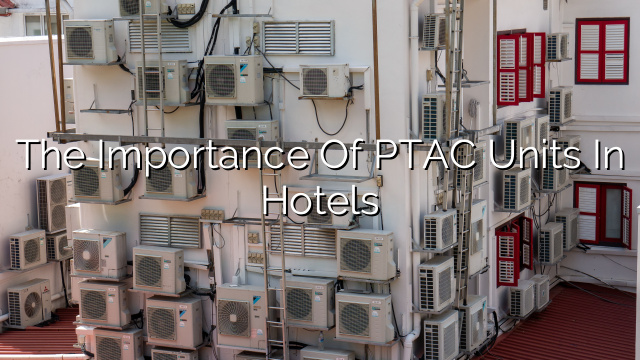A Guide to PTAC Units in Commercial Settings: Vital HVAC Solutions for Optimal Climate Control
In commercial settings, maintaining a comfortable indoor environment is crucial for the efficiency and productivity of employees and customers alike. One versatile and effective solution that addresses heating, ventilation, and air conditioning (HVAC) needs is the Packaged Terminal Air Conditioner (PTAC) unit. Whether you own a hotel, office building, or healthcare facility, understanding the benefits of PTAC units can help you make informed decisions for optimal climate control. In this blog, we will delve into the ins and outs of PTAC units, their advantages, installation tips, and maintenance practices.
Section 1: What are PTAC Units?
PTAC units are self-contained HVAC systems typically installed through an exterior wall in individual rooms. Combining heating and cooling capabilities within one unit, PTAC systems are highly efficient and convenient for commercial spaces that require individualized temperature control. These units are commonly found in hotels, hospitals, assisted living facilities, apartments, and office suites.
Section 2: Advantages of PTAC Units
2.1 Energy Efficiency
PTAC units have individual controls, allowing users to adjust the temperature according to their preferences. This localized control reduces energy waste by avoiding heating or cooling empty areas, leading to significant cost savings.
2.2 Easy Installation
Given their self-contained design, PTAC units are relatively easy to install, requiring minimal structural modifications or ductwork alterations. They commonly fit into existing wall sleeves, making them an ideal choice for retrofit projects.
2.3 Individualized Climate Control
Each room can have a PTAC unit, enabling occupants to personalize the temperature settings according to their comfort. This feature is particularly beneficial for hotels where guests have varying temperature preferences.
Section 3: Installation Tips for PTAC Units
3.1 Assessing Cooling and Heating Needs
Before purchasing a PTAC unit, it is essential to calculate the capacity required for each space. Factors such as room size, sun exposure, insulation conditions, and local climate play a role in determining the appropriate BTU (British Thermal Units) rating for efficient cooling and heating.
3.2 Proper Placement
To ensure optimal performance, PTAC units must be installed at the correct height and angle. Typically, they should be installed close to the floor to evenly distribute air throughout the space. Additionally, proper sealing of the exterior wall around the unit helps prevent drafts and energy loss.
3.3 Electrical Considerations
Proper electrical wiring and voltage requirements are vital for PTAC units. It is crucial to consult an electrician or HVAC professional to ensure compliance with local regulations and safety standards.
Section 4: Maintenance Practices for PTAC Units
4.1 Regular Cleaning
To maintain optimal performance and indoor air quality, regular cleaning of PTAC units is necessary. Filter cleaning or replacement, coil cleaning, and removal of dust and debris from vents are essential maintenance tasks.
4.2 Professional Inspections
Annual inspections by qualified HVAC technicians help identify any potential issues with the units. Timely inspections allow for early detection and resolution of problems, prolonging the lifespan of the PTAC units and maximizing their efficiency.
Conclusion:
In summary, PTAC units offer commercial spaces versatile and efficient heating and cooling solutions. Their individualized climate control, ease of installation, and cost-saving benefits make them an excellent choice for hotels, hospitals, and various business establishments. By following the installation tips and maintenance practices outlined in this guide, you can ensure longevity and optimal performance of your PTAC units. For more detailed information, expert advice, and quality PTAC units, consult trusted HVAC professionals, who can guide you through the entire process, from installation to ongoing maintenance.














